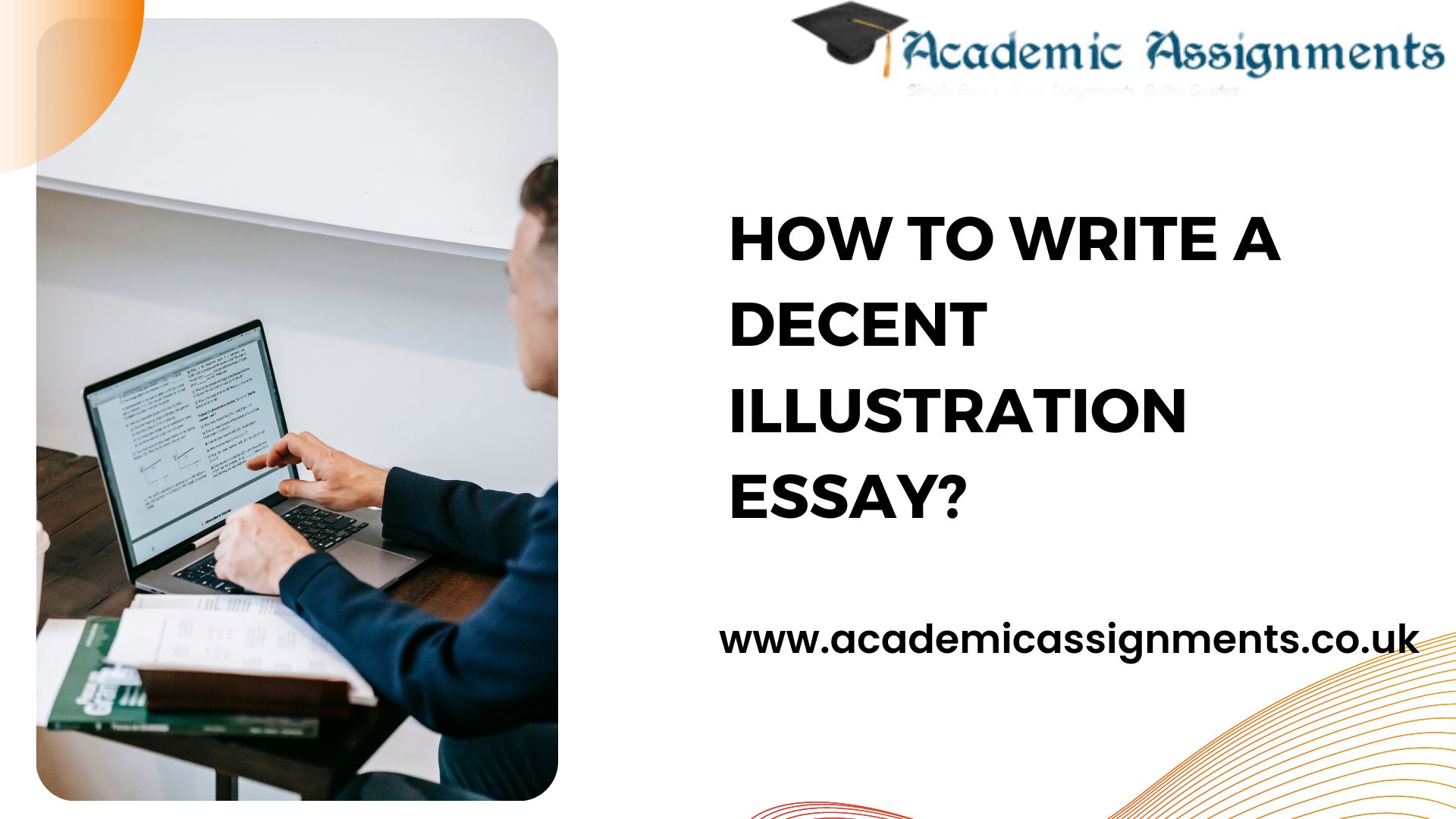How to Write a Decent Illustration Essay
What is an Illustration Essay?
An illustration essay is a piece of instructive writing that demonstrates the existence and behaviour of an object in specific. An illustration essay is also known as an exemplification paper. It indicates that in addition to summarising empirical data, the author must also provide their interpretation. It is not a brand-new discovery but a synthesis of experiences with vivid examples that elucidate the topic. These instances are what distinguish an excellent illustration essay. There is no need to concentrate on perceptions or findings. A topic notion must be demonstrated with supporting facts so that readers may see themselves in those scenarios. A logical sequence of examples is required to explain the results. Use individuals, situations, and observations to render a subject more relatable.
Purpose of Illustration Essay
An illustration essay aims to present explanatory cases that substantiate a thesis statement. Suppose you persist with questions about how to write a thesis statement. Illustrative writing necessitates creativity and attention to detail. In broad terms, the writer’s principal duty is to locate supporting written material that might be used to illustrate the main theme.
Both the writer and the audience can profit from illustrative writing. In conjunction, this form of the project can help pupils develop their inventiveness and comprehensiveness. An illustrative essay, on the contrary conjunction, stimulates readers to think creatively since it requires them to conjure up a mental image.
Steps for Writing an Illustrative Essay
- Step 1: Select a topic of your choice, something that concerns you, determine the primary item, and then compose regarding it. Below is a selection of illustration essay themes to get you started.
- Step 2: After identifying the topic, determine the points discussed in the illustration essay. Think of at least 3 critical points and discuss why you are in favour or against the point. A thesis statement which is written carefully helps in presenting the particular notion of the topic and aids as a way for creating thoughts in the paragraph body.
- Step 3: After formulating a thesis statement, it is important to collect shreds of evidence. Doing thorough research on the topic to determine the best examples for the essay. To find evidence related to the thesis, it is better to rely on scientific results, literary work, or historical events or by utilizing one`s own experience are the main constituent of facts to be discussed. Choosing as many instances as possible is important as then illustrating them.
- Step 4: The written material must be in an organized manner as well as concise. Setting ideas on the appropriate path may be difficult. This is when a well-thought-out essay plan comes in helpful. Make a list of all major elements and suggestions for structuring every description to ensure the overall structure is easy to read.
- Step 5: Based on the length of the essay, mention specific details in every main paragraph. Demonstrate why you choose a particularly illustrative case at the start of every phrase, and then back it up with useful information from the earlier study.
- Step 6: Cross-check the overall essay for stylistic and grammatical errors. It is an important process of writing any paper as it satisfies all the requirements of academics.
- Step 7: Before submitting the final essay, read it again to ensure it is enjoyable and can answer any queries.
Types of Examples in an Illustrative Essay
Several unique approaches may take your illustrated writing to the next level. Some are listed below-
- Addressing contemporary events or historical facts
- Utilizing personal experience
- Contrasting objects
- Involving the findings of scientific study in a similar niche
- Providing statistical details
There are different methods to detail the examples to be populated in the body of the paragraphs. These are discussed below-
- Personal Observation – Researching a particular thing connected to your selected topic requires a great deal of personal observation. A nice illustrative essay would describe any event, circumstance, region or individual you have witnessed and express your opinions on the issue, including sensory expressions while discussing your observing experiences. Remember that your viewers must watch the incident as though they were there to see it.
- Personal Memories – Personal recollections provide new ideas to support your primary point, which you may discuss with the audience. After all, it is up to you to interpret the significance of the events in your piece of writing. Consider important lessons for life from your perspective. Because it is believed that recent experiences are of the utmost importance, they should be described first. Such perceptions, in particular, should appear plausible to what you were thinking when writing so that you may present a scenario in the same manner you perceived it at the time.
- Interview – It is a personal conversation with experts relating to your issue. These folks can provide intriguing examples that help your work separate from the crowd. Before contacting a specialist in the sector of your selection, undertake a comprehensive study and make an exhaustive list of every issue and query.
Basic Structure of an Illustrative Essay
An illustrative essay involves writing an introduction of the chosen topic, the body of the paragraph and the conclusion.
- Introduction – It introduces the concept. Begin by establishing an idea about which you will write. Proceed to the thesis statement, which summarizes the key concept and serves as the foundation of your introduction. It serves as an initial point for more evidence. It should be memorable. You can use an inspiring quotation, intriguing facts, statistics, a story, or a real-life incident to pique the reader`s interest.
- Body Paragraphs – The evidence is illustrated and explained in the body of the paragraphs. An introduction unlocks a passageway into an area, representing what the audience discovers. Each of the paragraphs has identical layouts and is made up of the following elements:
The key supporting argument in the paragraph is the topic sentence. The background sentence begins the illustrative section. At least 3 of them should be discussed. Research phrase elaborates on the subject by paraphrasing or quoting information.
Analyze and describes how it relates to the subject of your study and thesis.
The conclusion summarizes a concept and brings a paragraph to wrap up. - Conclusion – It should restate the notion from the opening statement and avoid including additional information. Its goal is to construct the last line by gathering the previously given facts, concepts, etc. This is a brief yet significant paragraph that serves as the final picture of your work.
Paragraph Structuring
Be certain that your paragraphs are well-balanced while composing an illustration essay. This will make your paper appear more cohesive and consistent. That is, they should have sufficient details to cover all required components. To effectively format your writing, follow the guidelines below:
- Begin every paragraph with a subject phrase that reflects the section’s primary concept.
- Only one concept per paragraph should be discussed.
- Every paragraph should support the thesis statement.
- The paragraph should conclude with a conclusion sentence that summarizes it.
References
- Bailey, S., 2017. Academic writing: A handbook for international students. Routledge.
- Ehrlich, P., Dobkin, D.S. and Wheye, D., 1988. Birder’s handbook. Simon and Schuster.
- Holders, O., Handbook, P.T., Washbrook, D., Cohn, H., Smith, I., Clifton, R., Lenman, R. and Dusinberre, W., Sample source-based essay.
- Kane, T.S., 2002. Oxford essential guide to writing.
Author Bio: Mark is a seasoned writer at Academic Assignments, offering top-notch essay writing services at affordable rates. Trust his expertise for impeccable results. With his deep understanding of various subjects and meticulous attention to detail, he ensures that every piece of writing is crafted to perfection. Clients appreciate Mark’s professionalism, reliability, and commitment to providing the best possible outcomes. Entrust your essay to him and experience the exceptional service that separates Academic Assignments.

 Blogs
Blogs





